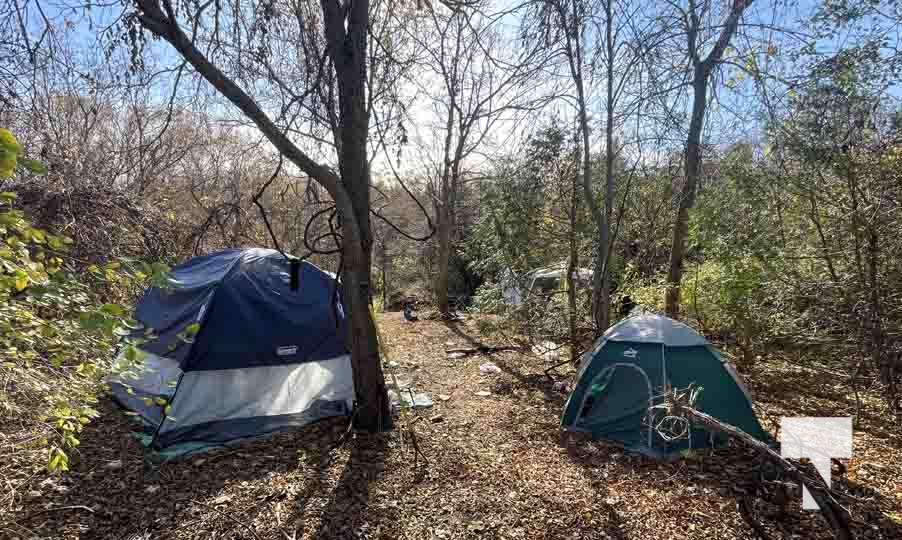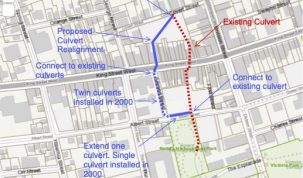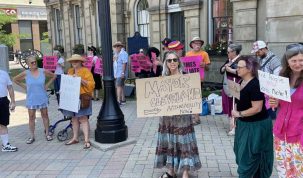(Today’s Northumberland file photo)
Editor’s Note: This was a 51-page document concerning the decision. Today’s Northumberland tried to cover the main points, but we have also included the link for anyone who would like to read the entire document.
A ruling handed out recently by a Ontario Supreme Court Justice could have effects on every town or city in the province dealing with homelessness.
On January 27, Justice Michael Valente refused an injunction to dismantle a homeless encampment on public property approximately ½ acre in size.
The application was brought forth by the Regional Municipality of Waterloo concerning the, “prohibition against erecting any type of structure, including a tent,” on a parcel of public landed owned by the city of Kitchener.
In the decision it states, “the application touches on the unfortunate, complex and nationwide social issue of homelessness.”
The application by the city takes the position that a number of homeless people are contravening the by-law of living on the public property.
But a number of people living at the encampment filed notices of appearance and alleged that the by-law and the trespass noticed issued breaches their section 7 Charter rights to life, liberty and security of person and second 15(1) equality.’
The position of the city is that it doesn’t require the court’s assistance in determining its legal rights to evict any trespasser on public owned property who are breaching a by-law which prohibited activities include, erecting, without authorization, any form of structure on the lands as well as bringing any dangerous, illegal or flammable goods on the lands.
Remedies including a ticket or exercise its rights under the Trespass to Property Act.
The encampment area started in December 2021 and at the time of the report approximately 53 people were living amongst the ½ acre property.
As of July 2022, the monthly costs for the encampment are approximately $80,000 which includes security services, garbage pick-up and janitorial services to clean up a nearby washroom.
In the encampment there were men, women, couples, members of the 2SLGBTQ+ community, Indigenous people, members of racialized communities as well as persons suffering from disabilities, substance abuse and domestic abuse survivors.
The Encampment Policy provides for a two-step approach prior to enforcement of the by-law.
The first step calls for the Region’s Community Services department to reach out to persons experiencing homelessness to encourage and assist them in accessing safer and healthier alternatives, including housing, support services, shelter and more permanent housing options.
The second step requires that, “enforcement occur only after all reasonable outreach and support efforts have been provided without success and after reasonable notice of the need to vacate has been given.”
Even after a notice of eviction has been made, the decision states, “enforcement shall be completed in a way that respects both the safety of all concerned and the dignity of the individuals experiencing homelessness.”
From May to June, 2022, region staff met with a number of agencies to ensure person-centred supports and services were offered to encampment residents.
Case workers visited three times a week for a six week period and spoke to 38 individuals; of these 38 residents, 22 were spoken to on one occasion.
At different times there were a different number of tents. On May 12, 2022 there were approximately 40 tents and 32 residents and on May 17, 2022, there were 63 tents and 50 individuals.
It was the region’s determination that the conditions posed a “risk to health and safety of the encampment residents as well as to that of others.”
As a result, the region determined the encampment needed to be disbanded.
The adverse impacts of the encampment were defined as follows:
rat droppings and rodent burrows
human feces and urine on the property
the consumption of alcohol and drugs
the presence of barbeques and propane tanks in and around the tents creating a potential fire hazard
physical altercations
repeated trespasses onto the neighbouring commercial plaza and complaints from local business owners.
Justice Valente stated, “I am also of the opinion that, absent suitable housing, does not closing the encampment simply moves all these risks elsewhere. Furthermore, does not the region have some responsibility to take further steps to mitigate these risk?”
Dr. Andrea Sereda is a physician practising at the London Intercommunity Health Centre in London, Ontario and has been providing health care to the homeless for 12 years.
Dr. Sereda stated there are many health risks associated with homelessness.
a) The forced transience face by unhouse people, which includes eviction from encampments, interrupts the ability of healthcare teams to complete diagnostic and treatment plans.
b) Other healthcare problems created by encampment evictions include:
I. The inability to locate patients once they have been forced to leave can lead to their discharge from programs which require regular attendance;
ii. Acute conditions such as frostbite, exposure, and heatstroke due to the loss of tents, clothing and medications;
iii. The exacerbation of such mental health conditions as depression, anxiety, PTSD, and panic disorders; and
iv. Increased substance use and fatal overdoses
c) For individuals experiencing homelessness, mot of each day is spent on survival living, including accessing food, shelter, and hygiene. Because most of the day is consumed with securing these basics, acute and chronic health conditions are often not prioritized by patients experiencing homelessness.
d) Physically locating a patient who is homeless can be very difficult which often results in a delayed diagnosis and treatment of both acute and chronic conditions.
e) “People who have nowhere to sleep commonly have profound sleep deprivation, which can impact physical and mental health but also contribute to a greater risk of death through mechanisms like overdose.”
f) Because of the persistent onslaught of environmental factors such as heat, cold, rain and snow, individuals living unhoused are subject to injuries and acute illnesses. In these circumstances, it is difficult for healthcare providers to help the homeless move beyond the treatment of the acute illness at the cost of not addressing chronic conditions. The focus on acute care rather than preventative care for chronic conditions “increases morbidity and mortality from those chronic conditions.”
In contrast, Dr. Sereda describes the advantages of living in an encampment as compared to living in a public space in this way:
a) decrease forced transiency which increases the odds that the unhoused can maintain a connection to such outreach services as healthcare, street outreach for basic needs (food, clothing), delivery of medications and harm reduction supplies.
b) Encampments decrease isolation and risk of fatality. By being forced to move into the margins, people place themselves at greater risk of harm because they are alone and disconnected from routine services. This places them at greater risk of violence, overdose, and loss of connection to medical services.
c) Encampments give people sense of community. The benefits of this include increased mental heath stabilization, increased chances of being helped during an overdose, and emotional support.
d) Encampments minimize sleep deprivation. Many unhoused people with nowhere to sleep need to stay up all night due to fear of violence and theft if they sleep alone in the open.
f)Encampments provide physical and mental rest. It is both physically and mentally exhausting to have to constantly move and search for new places to shelter. Being able to remain in one place gives people a chance to rest and focus on recovery.
Dr. Sereda also believes with respect to the advantages of living in an encampment over a shelter. She explains those advantages as follows:
a)In encampments, couples or “survival partners” can remain together.
Almost always, there is insufficient shelter options for couples.
b) Shelter stays are inherently unpredictable and precarious. Many people can find themselves abruptly evicted in any weather condition.
c) Shelter spaces are often abstinence-based with policies that refuse to adopt a harm reduction approach to provide increased safety and support for people who are experiencing homelessness and using substances.
d) Encampments provide relief from the physical burden of leaving and entering shelters every day. Additionally, when people must leave the shelter each day, they are left with nowhere to rest or decompress until they return at night.
e) Shelters can be re-traumatizing for people with a history of trauma or abuse. People with this history may be triggered by a congregate setting of strangers.
The region did stat that since January 2022, “there has been a week over week surplus capacity in its shelter system.”
“In short, the region argues that there is more than sufficient capacity to accommodate the approximately 50 encampment residents where the encampment to be cleared.”
A number of residents were interviewed as part of the court process. The decision states even with the region offering emergency shelter accommodation to seven of the residents, all refused the regions offer.
Dr. Sereda’s findings conclude that 95% of the encampment residents are substance dependent.
“It is also Dr. Sereda’s evidence that shelters have inconsistent practices around substance use.”
Justice Valente concluded that the region does not have sufficient shelter spaces.
“I find that the number of homeless persons in the region far outnumber the available shelter beds such that many of the region’s homeless have no alternative but to sleep outside.”
“Furthermore, I accept that it is simply not a matter of counting the number of spaces. To be of any real value to the homeless population, the space must meet their diverse needs, or in other words, the space must be truly accessible. If the available spaces are impractical for homeless individuals, either because the shelters do not accommodate couples, are unable to provide required services, impose rules that cannot be followed due to addictions, or cannot accommodate mental or physical disability, they are not low barrier and accessible to the individuals they are meant to serve.”
“I am not satisfied that the region has adequate capacity to shelter the approximately 50 encampment residents given that its shelters are not low barrier or truly accessible.”
Justice Valente explains his decision regarding whether the by-law deprives the encampment residents of one of the protected Section 7 Charter of Rights
Life
“I conclude that the ability to provide adequate shelter for oneself is a necessity of life that falls within the right to life protected by section 7 of the Charter. I have reached this conclusion because the very clear and uncontroverted evidence before me is that exposure to the elements without adequate shelter can result in serious harm, inducing death. Because the by-law prohibits the erection of shelter protection that is necessary to protect homeless individuals from risk of serious harm, and there is currently inadequate shelter beds in the region, I conclude that it violates the Charter protected right to life.”
Liberty
“Liberty is a phrase capable of a broad range of meaning. In my view, this right, properly construed, grants the individual a degree of autonomy in making decisions of fundamental personal importance.”
“I have found that as a fact there are not enough accessible shelter beds for the region’s homeless population. If evicted from the encampment, the residents will likely be forced to live in the rough or set up camp somewhere else because there is an insufficient supply of low-barrier accessible beds in the region. In these circumstances creating shelter to protect oneself is, in my opinion, a matter critical to any individual’s dignity and independence. The region’s attempt to prevent the homeless population from sheltering itself interferes with that population’s choice to protect itself from the elements and is a deprivation of liberty within the scope of section 7.”
“The question is not whether the encampment residents’ circumstances are self-made, but rather, whether enforcement of the by-law will make the residents’ already dire predicament worse.”
“The responding parties argue that enforcement of the By-law to evict the Encampment residents would have multiple and severe negative consequences on them. Those negative consequences include lack of stability, difficulty accessing services, increased health problems, and risk of death.
The consequences are more severe for those encampment residents who suffer from mental illness or substance abuse to the extent that they lack capacity to understand the legal consequences of the By-law’s enforcement.
On the other hand, the evidence points to the conclusion that there are many benefits to encampment living. Both the Named Respondents and Dr. Sereda have attested to these benefits which include a safe place to rest, access to social services and healthcare, a sense of community (which correlates with mental health stabilization and emotional support), and privacy.
Given that the accepted purpose of the By-Law is to prevent physical damage to the Designated Premises and disruption to the Region’s operations as well as the use and enjoyment of the
Designated Premises by others, I find that the proposed eviction of the Encampment residents is grossly disproportionate to the By-Law’s goal. In short, the impact of the enforcement of the By-Law is “completely out of sync with the object of the law.”
Justice Valente concludes that the by-law to evict the encampment residents, “breaches the rights established by section 7 of the Charter.”
“The Constitution of Canada is the supreme law of Canada, and any law that is inconsistent with the provisions of the Constitution is, to the extent of the inconsistency, of no force or effect.”
Justice Valente also stated prior to the enforcement of the by-law, “the region did not use all reasonable outreach and support efforts to connect with the encampment residents and address their individuals needs on a case-by-case basis.”
Justice Valente concluded, “the by-law violates section 7 of the Charter in that it deprives the homeless residents of the encampment of life, liberty, and security of the person in a manner not in accordance with the principles of fundamental justice.”
“I decline to declare that the homeless individuals living in the encampment on the property are in breach of the by-law.”
Today’s Northumberland reached out to Town of Cobourg CAO Tracey Vaughan stated, “The Town of Cobourg is carefully reviewing the Ontario Superior Court of Justice Decision regarding encampments on public property. A report will be coming back to Council in the near future with information on how this ruling may impact operations in the Town of Cobourg.”
























